SCHOOL BLOG
学科ブログ
International Student Interview Vol.4 “Loving Biotechnology and Kanji – Chasing Dreams from Sri Lanka to Japan”

This time, we’re introducing Dinuja, an international student from Sri Lanka studying in the Department of Biotechnology. In our interview, she enthusiastically talked about the unique features of her native Sinhala script, her love for Japanese kanji, and her aspirations for the future.
(Japanese version here)
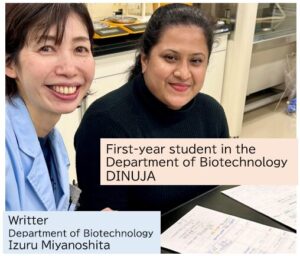
A few days ago, she showed me her notebook. Beneath the neatly written Japanese, I noticed some unfamiliar, mysterious-looking characters. I couldn’t help but exclaim, “Wow, what is this?” The script was rounded, with little curly tails—almost like looking at the backside of a pig! It was so charming that I found myself mesmerized. Dinuja told me it was Sinhala, the script used in Sri Lanka.

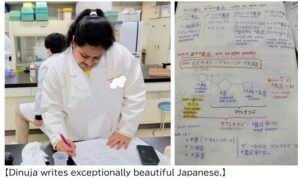
◆ The Charm of Sinhala Script
Miyanoshita:
“How do you read this character?”
Dinuja:
“That’s the letter ‘O’. Japanese has 50 basic hiragana characters, and Sinhala has around 60.”
Miyanoshita’s Comment:
Looking at the Sinhala chart Dinuja showed me, every character has a soft, rounded shape. Curious about why the script is so curved, I did some research. It turns out that in ancient times, Sinhala was inscribed on palm leaves. Since using straight lines could tear the leaf, people naturally developed rounder characters. It’s fascinating how the writing surface influenced the style of the script!
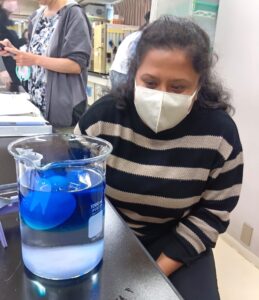
◆ A Love for Kanji – Dinuja, Who Fell in Love with Characters
Miyanoshita:
“Your Sinhala script kind of resembles hiragana, doesn’t it?”
Dinuja:
“Yes, hiragana uses a lot of curves, so it feels similar. Characters like ‘は’ (ha), ‘ぬ’ (nu), ‘め’ (me), and ‘む’ (mu) were easy for me to memorize. But actually, I love kanji even more.”
Miyanoshita:
“Kanji? Even though many Japanese people find them difficult, why do you like them?”
Dinuja:
“I’ve always liked writing characters. Kanji has a lot of straight lines, which makes it look cool—very different from Sinhala. Plus, each kanji has meaning, which is really interesting.”
Miyanoshita:
“So you enjoy the differences between scripts. Do you have a favorite kanji?”
Dinuja:
“I love the character 『微』 (bi – meaning ‘tiny’ or ‘subtle’). It was really hard for me to remember at first, so I practiced it again and again. That’s why I feel so attached to it.”
Miyanoshita:
“You must get to use your favorite kanji a lot in biotechnology—with words like 微生物 (microorganism) or 微小管 (microtubule).”
Miyanoshita’s Comment:
It was impressive to see how someone familiar with rounded scripts has come to appreciate the beauty of straight-lined kanji. The shift in her perspective left a strong impression on me.
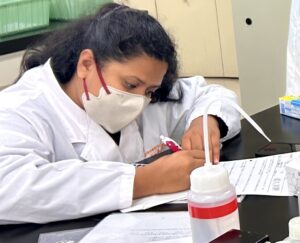
◆ A Famous Japanese TV Drama Inspired Her to Come to Japan
Dinuja:
“What first sparked my interest in Japan was the TV drama Oshin, which I watched in Sri Lanka. The story was so touching, and I was fascinated by how the actors wore kimono. The cultural differences felt so fresh and intriguing. I started dreaming about visiting Japan someday.”
Miyanoshita:
“Oshin! That’s a classic. Life in that era was quite different from modern Japan, but I can see how it left a deep impression. After coming to Japan, were there any moments that made you especially happy or surprised?”
Dinuja:
“The happiest moment was receiving a perfect attendance award when I graduated from Japanese language school. I never missed a day—not even when I wasn’t feeling well. I was proud of myself for pushing through, and it meant a lot when my teacher praised me.
The biggest surprise was definitely the earthquakes. We rarely experience them in Sri Lanka, so when I felt a magnitude 3 tremor for the first time, I was really scared.”
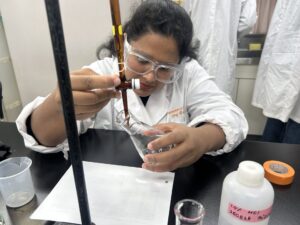
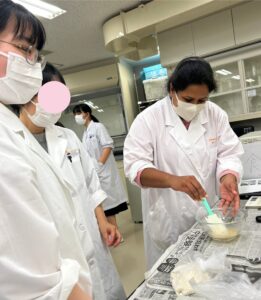
◆ Balancing Studies and Work – Dinuja’s Powerful Lifestyle
Miyanoshita:
“You’re so curious and passionate—do you find it hard to balance studying with part-time job?”
Dinuja:
“Yes, I work night shifts at a beef bowl restaurant. It can be tiring, but during breaks I review quizzes and work on assignments. I genuinely enjoy learning about biotechnology, so even with little sleep, It’s not a problem for me.”
Miyanoshita:
“That’s incredible. Do you have any advice for other international students who wish to enter vocational schools in Japan?”
Dinuja:
“I think the most important thing is how interested you are in the subject. The biotechnology department has lots of lectures, notes, and lab work—it’s intense. But because I truly love the field, I can keep going. Without that interest, I think it would be very tough.”
Miyanoshita’s Comment:
Seeing Dinuja work hard at her part-time job late into the night while staying focused on her studies reminded me of Oshin herself. Her determination and consistent effort to move toward her dream will surely inspire many others.

◆ Her Dream for the Future
Dinuja:
“I’m very interested in the medical field. I want to work in a job where I can analyze patient samples, discover causes of illness, and contribute to treatment.”
Miyanoshita’s Final Comment:
Watching Dinuja pursue her studies with such dedication and ambition—even across national borders—is truly inspiring for us as educators as well. We’ll continue to share the voices of international students with diverse backgrounds and experiences, so stay tuned!
Written by Izuru Miyanoshita 【178-English】








